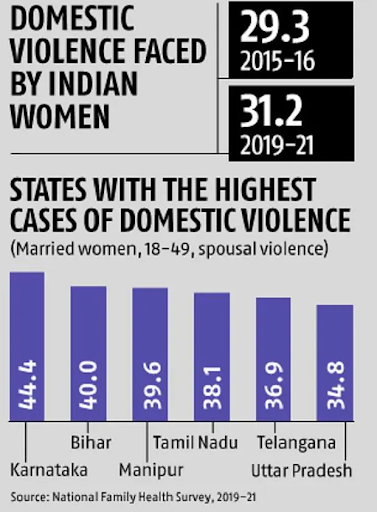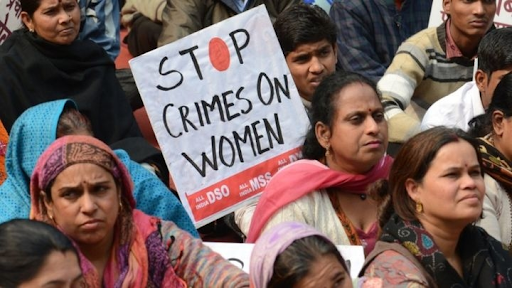Behind Closed Doors: The Underreported Reality of Domestic Abuse in India
Domestic Violence is an issue that often tends to lurk in the shadows. The unsettling truth is that it could be affecting anyone you know – a neighbour, a colleague, a friend or a family member. While anyone can be a victim, Domestic Violence tends to affect women disproportionately due to a variety of factors enforced by the patriarchal society we live in. This is the harsh reality for many women in India too – statistics back this up. According to the National Family Health Survey (NFHS), 31.2%, of nearly 1 in 3 women in India is likely to have experienced spousal violence. These numbers go beyond mere statistics; they represent the lived experiences of countless women who endure the devastating effects of domestic violence. Let us delve into the causes behind this pervasive issue, and what can be done to tackle it.
Why does domestic violence happen?
India is a highly patriarchal society with most marriages being patrilocal, i.e. marriages where the couple settles in the husband’s family home. Although perspectives are changing, women are still expected to prioritise the household over their careers or financial independence. This power imbalance combined with a notorious stigma against divorces and speaking out against abuse, contribute to a high rate of domestic violence in India.
What does domestic violence look like? How do I know if I or someone I know is being abused?
Domestic abuse, also called “domestic violence” or “intimate partner violence”, is a pattern of behaviour that is used to gain or maintain power and control over an intimate partner. Domestic abuse and violence come in various forms. It can be physical, psychological, sexual, economic or emotional. Some common signs of domestic abuse are physical mistreatment (grabbing, pushing, hitting), excessive monitoring and control and sexual pressure and coercion. If you find yourself being fearful of your partner or making excuses for their behaviour, it might indicate abuse.
If someone you know may be experiencing abuse, some signs to look out for are unexplained bruises or injuries, withdrawn, agitated and anxious behaviour, substance abuse, showing signs of fear, seeking permission to go out or socialise, constant calls, texts, or tracking by the partner and limited access to money or resources.
For more signs of potential abuse: https://www.un.org/en/coronavirus/what-is-domestic-abuse
What are the laws and regulations in place in India?
Coming to the legal side of things, Domestic abuse in India is primarily addressed through the Indian Penal Code (IPC) and specific legislation.
Section 498A: Addresses cruelty inflicted by husbands or their relatives on women, punishable with imprisonment of up to three years.
Section 304B: Deals with dowry-related deaths, imposing a minimum of seven years of imprisonment for the accused.
Protection of Women from Domestic Violence Act, 2005 (PWDV Act):
- Primarily addressing abuse faced by married women, it encompasses physical, sexual, or mental violence, threats, and dowry-related issues.
- Extends protections to women in live-in relationships, broadening the scope beyond traditional marriages.
Dowry Prohibition Act, 1961:
- Addresses abuse related to dowry demands, with Section 304B of the IPC complementing it.
- Demanding dowry is punishable with a minimum of six months in jail, extendable up to two years.
It’s important to note that domestic abuse is frequently underreported in India, largely owing to the societal stigma that discourages women from openly addressing issues within an abusive marriage.
What do I do if I am being abused? What if someone I know is?
If you recognize signs of domestic abuse within your household, know that you are not alone. The abuse is not your fault and no one deserves to be abused. In such a case, you should take the following steps –
i) Confide in a trusted friend or family member who you know will be non-judgemental and can offer you support.
ii) Contact Helplines – National Commission for Women Helpline – 7827170170
Lawyers Collective Women’s Rights Initiative LC WRI – pro-bono legal aid cell for domestic violence cases – (011) 24373993/ 24372923
24×7 Gender-based Violence Crisis Line by Aks Foundation – 87930 888 14
Visit http://www.ncw.nic.in/helplines – for more helplines
iii) Explore Legal Options – Familiarise yourself with Indian laws regarding domestic violence and seek legal help if possible and necessary. Legal professionals can provide insights into protective measures available to you.
iv) Keep a record of abusive incidents, noting dates, times, and details. This documentation can serve as evidence if legal action becomes necessary.
If someone else you know is being abused, here’s what you can do:
- Supporting someone facing abuse involves creating a safe, non-judgmental space for them to share their feelings. Let them share how they feel without any judgment. Offer a hand in finding practical help, like helplines or support groups, and let them know you’ve got their back. Suggest professional counseling to tackle the emotional side of things, and always respect whatever decisions they make about reporting or legal action.
CONCLUSION
Domestic Violence against women may often take on a clandestine nature. But it does not take place in a vacuum. It is reinforced by the overarching patriarchal system that leads to issues like financial dependence, societal stigmas, power imbalances, etc. that may lead to domestic violence. Combating domestic violence against women is effectively done when the underlying systems of misogyny and patriarchal oppression are addressed and challenged. Spread the word within your communities and actively challenge the stigma and taboo that often shroud these issues. As we mark The International Day for the Elimination of Violence Against Women, let it serve as a reminder that knowledge is indeed power—the power to advocate for change, foster understanding, and ultimately create a society where survivors are heard, supported, and free from the shackles of silence.
Author



